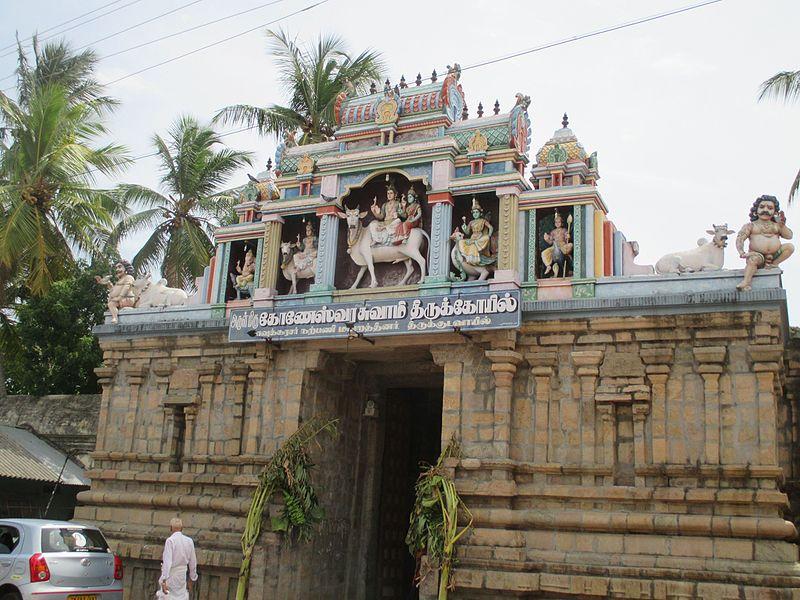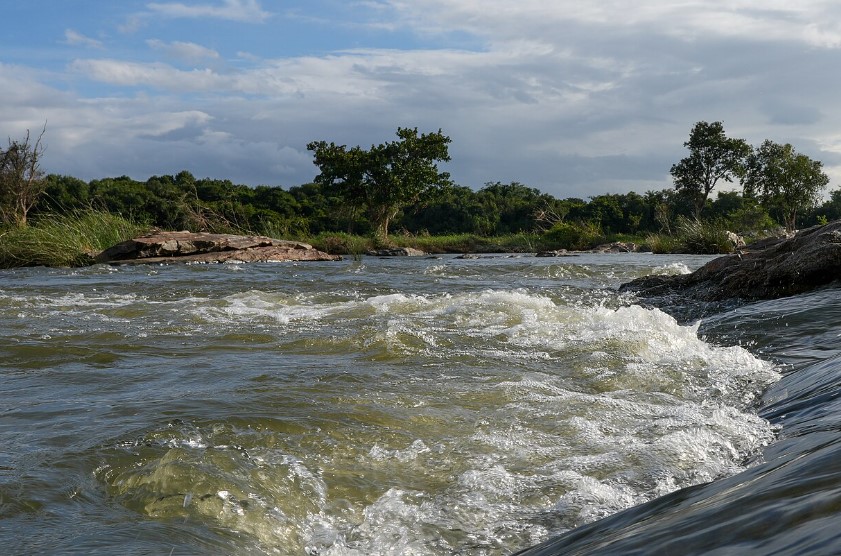- The Koneswarar Temple, located in Kudavasal in the Thiruvarur District of Tamil Nadu, is a significant Hindu shrine dedicated to Lord Shiva.
- It is one of the 276 Devara Paadal Petra Shiva Sthalams and is notably the 211th in the sequence.
- This temple, revered for its Swayambhu Murti (self-manifested) form, is also recognized as the 94th Shiva Sthalam on the southern bank of the river Cauvery in Chozha Nadu.
- Constructed by King Kochengat Chola, the temple exemplifies the Maadak Koil architectural style, featuring an elevation designed to prevent elephants from entering the sanctum.
- The temple faces west and consists of two corridors, distinguished by a unique main tower that is not tiered. Instead of a traditional Gopuram, visitors are greeted by a stunning sculpture depicting Lord Shiva and Goddess Parvathy.
- The temple has a rich history of consecration ceremonies, with the last Maha Kumbabishekam taking place in 2012, and previous ceremonies in 1985 and 1970. The sacred site was historically known as Kathali Vanam and Vanmikachalam.
- The main deity, Koneswarar (also called Konanathan), is worshipped alongside his consort, Periya Nayaki (or Bhriha Nayaki).
- Notably, the rays of the sun illuminate the deity for three days during the Panguni month (March-April), enhancing the temple's spiritual significance.
- Theertham, or sacred water, is referred to as Amrutha Theertham, located in front of the temple, and the Sthala Vriksham (temple tree) is a plantain.
- The temple has been praised in the hymns of Saivite saints like Sambandar and Arunagirinathar, the latter of whom composed Thirupugazh dedicated to Murugan of this temple.
- Koneswarar Temple stands as a cherished pilgrimage site, celebrated for its divine presence and cultural heritage.
- Koneswarar Temple, located in Tirukudavayil in the Thanjavur District, is an ancient shrine dedicated to Lord Shiva, believed to have been built before 660 AD.
- This Maadak Koil was constructed by Ko Chenkann Cholan on an elevated platform, which adds to its unique architectural significance.
- The principal deity, Koneswarar, is worshipped alongside Goddess Periyanayagi. The temple features an impressive 80-foot tall Rajagopuram and encompasses two prakarams (circumambulatory paths), enhancing its grandeur.
- Theertham, or sacred water, is known as Amirtatheertham, which holds spiritual importance for devotees. The temple is renowned for its vibrant celebrations of festivals such as Arudra Darisanam and Maasi Magam, attracting many visitors and pilgrims.
- For those wishing to visit, the temple is conveniently accessible from Koradacherri railway station, located just 10 kilometres away. The rich heritage and devotion surrounding Koneswarar Temple continue to make it a cherished pilgrimage site in the region.
HISTORY:
- The ancient Koneswarar Temple, built by King Kochengat Chola, is a significant Maadak Koil characterised by its distinctive architectural style. To reach the shrine of Lord Shiva, devotees ascend 18 steps, leading them to the sacred space. The lower section of the temple is referred to as "Kudavayir Kottam," which is steeped in history, as it is believed that King Kochengat Chola imprisoned his enemy, Seran Kanaikkal Irumporai, within this kottam.
- This temple holds historical importance and is mentioned in ancient texts such as the Puranaanuru and Aganaanuru, dating back to the Sangam period (300 BC – 300 CE). Renowned poets Kudavayil Keerthanar and Kudavayil Nallathanar have also sung praises of the temple, contributing to its literary legacy.
- Historically, this place has been known by several names, including Garudathiri, Kathalivanam, and Vanmikaachalam, while the temple itself is referred to as "Perunthirukkoil."
- The temple features four stone inscriptions that date back to the reign of Chola King Kulothungan III, providing insights into its historical and cultural significance.
PURANIC SIGNIFICANCE 1:

Mouth of the Kumbha and the Great Flood
During the Great Floods (Pralaya), Lord Brahma placed the Vedas in a pot of nectar, which was subsequently swept away by the deluge and carried southward. To recreate the world, Lord Shiva, disguised as a hunter, shot at the pot. The pot shattered, and its pieces fell at various locations, where Lord Shiva manifested as Swayambu Lingams. The mouth of the pot fell at this site, where Lord Shiva also appeared as a Swayambumurthy, later becoming covered by an anthill.
Garuda’s Mission to Rescue His Mother
Another legend recounts how Garuda, the eagle associated with Lord Vishnu, worshipped Shiva at this location. Garuda's mother, Vinatha, was enslaved by a demon king named Kathru. In his quest to rescue her, Garuda fetched a pot of nectar from Brahma’s abode. However, a demon seized the pot and placed it atop an anthill. Garuda defeated the demon in battle, but upon returning, he found the pot covered by the anthill. In his search, he dug through the anthill with his beak and discovered a Lingam underneath. He prayed to Lord Shiva, explaining his ordeal, and Shiva, pleased by Garuda's devotion, helped him rescue his mother from the demon’s grasp. The scar on the Shiva Lingam is believed to be a mark left by Garuda's beak, and thus images of Garuda can be found in the temple, a feature typically seen in Vishnu temples.
Maadakovil Heritage
Kochengat Chola, a notable king of the Chola dynasty and one of the 63 Nayanmars (Saivite saints), is credited with building this temple. He is said to have attained spiritual rebirth as a spider that fought an elephant over the worship of Shiva in a previous life. His red eyes at birth led to his name, meaning "king with red eyes" in Tamil. As a devout follower of Saivism, he constructed seventy Maadakovils—temples designed to be elevated so that elephants could not reach the sanctum. This temple is counted among those he established.
Etymology of Kudavasal
The name "Kudavasal" derives from the belief that Shiva appeared from a pot (Kudam) to relieve Drinabandu Munivar of leprosy, further enhancing the site's sacred significance.
Worship by Deities
Notable figures such as Garuda, Bhrigu Maharishi, Jatayu, Agni, Sutha Maharishi, and Thaalappiyar have worshipped Lord Shiva at this location, contributing to its spiritual heritage.
Vishnu’s Presence
During the deluge, it is believed that Lord Vishnu remained afloat in an earthen vessel that extended from Kudavasal to Kumbakonam, symbolising divine protection during chaos.
Sacred Temple Tank
It is also said that a part of the celestial nectar (Amritam) dropped at this site, making bathing in the temple tank considered sacred, particularly during the Mahamagam festival in Kumbakonam. This reverence adds to the temple's importance as a site of pilgrimage and spiritual cleansing.
PURANIC SIGNIFICANCE 2:
According to Hindu mythology, at the end of each "yuga," a cataclysmic flood known as "Pralayam" wipes out all living beings on Earth. To preserve the seeds of life and the four Vedas and Puranas, Lord Shiva, through Lord Brahma, arranged for them to be placed in a pot called “Amutha Kalas” (or Kumbham/Kudam in Tamil), filled with nectar (“amirtham”). This pot was adorned with flowers and cloth and tied with a string, and it was kept atop Mount Kailash.
When the Maha Pralayam commenced, it led to the destruction of all life, causing the Amutha Kalas to be displaced and float on the waters for many years. Eventually, when the deluge ceased, the Kalas settled in Kumbakonam. Lord Shiva then assumed the form of a hunter (Kiratha Murthy) and shot an arrow that split open the pot, allowing life on Earth to flourish anew.
As the pot broke, the decorative elements fell across various locations, each becoming a Shivalingam. The sites of these Shivalingams include:
- Kumbesam: The Amutha Kalas settled here, now known as the Sri Aadhi Kumbeswarar Temple. Legend says that Lord Kiratha Murthy created a Shiva Lingam from the Kalas's remnants, mixing nectar and sand, which resembles the neck of a pot (Kudamukku).
- Somesam: The string from the Kalas fell here, now the Sri Someswarar Temple.
- Nagesam: The vilvam leaves from the Kalas fell here, now the Sri Nageswarar Temple.
- Abhimugesam: The coconut from the Kalas fell here, now the Sri Abhimugeswarar Temple.
- Gautamesam: The sacred thread from the Kalas fell here, now the Shri Gautameswarar Temple.
- Kudavoil: The rim of the Kalas fell here, now the Sri Koneswarar Temple at Kudavasal.
- Kalayanallur (Saakkottai): The mid-portion of the Kalas fell here, now the Sri Amirthakalasa Nathar Temple.
- Bhanathurai: The spot where Lord Shiva broke the Kalas with his arrow, now the Sri Bhanapureeswarar Temple.
- Maalathivanam: The flowers from the Kalas fell here, now the Sri Aathikampatta Viswanathar Temple.
- Sri Kalahastheeswarar Koil: The Chandan from the Kalas fell here.
- Sri Ekambareswarar Temple: Other decorative items from the Kalas fell here.
- Kottaiyur Sri Koteeswarar Temple: Drops of nectar from the Kalas fell here.
The nectar from the Kalas is believed to have reached the Mahaamaham and Potraamarai tanks, spreading over an area of approximately 24 kilometres. Within this radius are five Shiva temples known as “Panchakurosa Sthalams” (pancha meaning five, kurosa being an ancient unit of measurement): Thiruvidaimaruthur, Koranattu Karuppur, Thirunageswaram, Swamimalai, and Dharasuram.
Another version of this legend involves Garudan (Garudazhvar), the king of birds. Sage Kasyaba had two wives, Kathru and Vinathai, and Garudan was the son of Vinathai, who was enslaved by Kathru. To free his mother, Garudan flew to the celestial world to retrieve the pot of nectar. While returning, he faced a demon who tried to steal the pot. Garudan placed the pot on an anthill to fight the demon and, after defeating him, discovered a Shivalingam instead of the pot.
Lord Shiva appeared before Garudan, who prayed for his mother's release. Shiva granted his wish, and Garudan stayed to worship the lord, establishing a temple at that site. The Shivalingam he found is believed to represent the rim of the Kalas. Scratch marks from Garudan's beak can still be seen on the Shivalingam, and sculptures of Garudan adorn the temple, a feature more commonly found in Vaishnava temples.
Saintly Associations
Saint Thirugnana Sambandar praised the temple in his hymns, referring to it as the Ezhilkola Mada Koil, meaning "beautiful Mada temple." Arunagirinathar also composed Thirupugazh in honour of Lord Murugan here.
PEOPLE WHO WORSHIPPED HERE:
Various celestial beings and sages, including Garudan, Suryan, Agni, Jadayu, Sages Suthama, Thalappiyar, Birugu, and Thirunapindhu, are said to have worshipped here. Sage Thirunapindhu, in particular, received a blessing from the lord, curing his leprosy through his devotion.
This temple continues to be a significant site of worship, celebrating the rich tapestry of mythology surrounding Lord Shiva.
ADMINISTRATION:
Koneswarar Temple is administered by the Hindu Religious and Charitable Endowments Department of the Government of Tamil Nadu (HR&CE), ensuring its preservation and the continuation of its religious practices.


